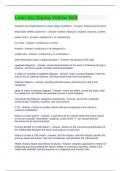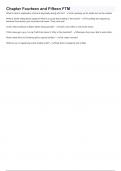Lean Six Sigma Yellow Belt
Solutions are implemented in which stage of DMAIC? - Answer- Improve and Control
What does DMAIC stand for? - Answer- Define, Measure, Analyze, Improve, Control
pareto chart - Answer- categorical x vs categorical y
run chart - Answer- continuous y vs time
boxplot - Answer- continuous y vs categorical x
scatter plot - Answer- continuous y vs continuous x
what information does a dotplot provide? - Answer- the spread of the data
spaghetti diagrams - Answer- visual representation of the work unit flowing through a
process, can show waste of motion and transportation
4 steps to complete a spaghetti diagram - Answer- draw a scaled diagram, mark the
area of focus, walk the process, and document travel time and distance
fishbone diagram - Answer- identify potential causes and document them into
categories
steps to make a fishbone diagram - Answer- select the effect, create the body, label
the categories, and define the potential causes in each category
manufacturing fishbone categories (traditional) - Answer- personnel, materials,
measurement, method, machine, and environment
CTQ - Answer- Critical to Quality; factors that are recognized to be critical to
customer satisfaction
What is a C&E matrix? - Answer- a tool that can be used to determine which inputs
on our are actually "most likely" suspects. Looks at the "X" (or inputs) that are
discovered to be most important.
Primary benefit of a C&E matrix? - Answer- allows for the numerical quantification of
the relationship between the inputs and outputs of a process
Steps to create a C&E matrix - Answer- list the outputs, rank the outputs, identify the
process steps and inputs, rank the contribution, and prioritize the critical items
FMEA (Failure Mode and Effects Analysis) - Answer- detailed, quantitative method of
analyzing and documenting the failure modes of a process, dynamic, needs to be
continually updated; primary purpose is to diagnose and prevent risks
, system FMEA - Answer- top level, early stage analysis
design FMEA - Answer- analyzes the systems, subsystems, parts, and components
of a product early in the design stage
process FMEA - Answer- focuses on: process flow, sequence, equipment, tooling
gages, inputs, outputs, and set points for each failure mode (most common)
potential failure mode - Answer- ways that a process could fail to meet the process
requirements or design intent
potential failure effects - Answer- the consequences of the potential failure mode on
the customer
current process controls - Answer- the existing controls and procedures that can
prevent or detect the failure mode
SEV (severity) column - Answer- an estimate of how severely the effect will impact
the customer
OCC (occurrence) column - Answer- likelihood that a cause will occur and will result
in the failure mode
DET (detection) column - Answer- likelihood that control will detect teh failure
RPN (risk priority number) - Answer- (multiply SEV, OCC, and DET) ranks the
priority of each failure effects
SPC (statistical process control) - Answer- The application of statistical techniques to
monitor and adjust an operation (used in control phase of DMAIC)
8 types of waste - Answer- (WORMPIIT) waiting, overproduction, rework, motion,
processing, inventory, intellect, and transportation
5 principles of lean - Answer- value, value stream, flow, pull, strive for perfection
TAKT time - Answer- understanding and responding to customer demand
at a 6 sigma level of quality, how many defects occur out of a million? - Answer- 3.4
3 sources of variation - Answer- Internal processes (always targeted first), design,
and raw materials
process baseline - Answer- average long term performance level of a process when
all variables are unconstrained, use this data to describe the process output at the
start of the project
7 phases of lean six sigma - Answer- recognize, define, measure, analyze, improve,
control, and realization





